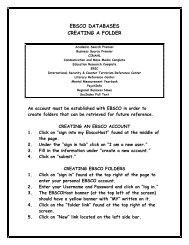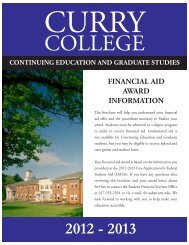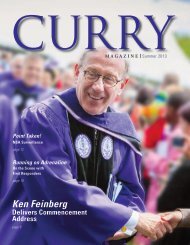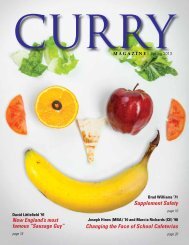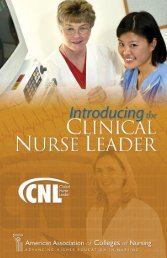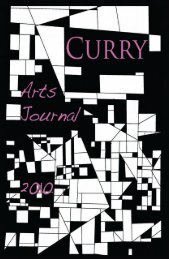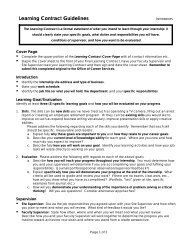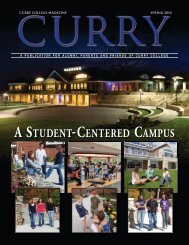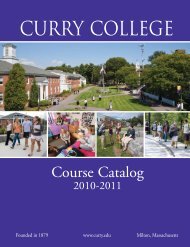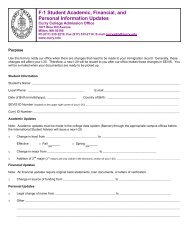Read the Curry College NEASC 2012 Self-Study Report.
Read the Curry College NEASC 2012 Self-Study Report.
Read the Curry College NEASC 2012 Self-Study Report.
Create successful ePaper yourself
Turn your PDF publications into a flip-book with our unique Google optimized e-Paper software.
92<br />
requirements.<br />
As described within Standard Four, <strong>the</strong> <strong>College</strong> has developed a comprehensive structure to<br />
support <strong>the</strong> delineation and use of learning outcomes at course, program and institutional<br />
levels. As it continues to support and institutionalize this effort, program objectives are and will<br />
be included on <strong>the</strong> website along with o<strong>the</strong>r program information. The display of <strong>the</strong>se<br />
program‐related learning outcomes was completed by <strong>the</strong> end of 2011. clxiii<br />
The <strong>College</strong> has appropriately and thoroughly reviewed recent revisions to <strong>the</strong> Higher<br />
Education Opportunity Act (HEOA). The review has been reassuring, with <strong>College</strong> staff noting<br />
only a few areas for improvement or where new initiatives were necessary to ensure<br />
compliance with changes to <strong>the</strong> regulations. An important example of how <strong>Curry</strong> responded<br />
efficiently and effectively to HEA revisions is <strong>the</strong> development and launch of a cost calculator to<br />
allow families to compare costs. <strong>Curry</strong> allocated significant resources to <strong>the</strong> cost calculator<br />
project, which commenced in June 2010 and concluded in September 2011, when <strong>the</strong> cost<br />
calculator became available on <strong>the</strong> <strong>College</strong>’s website. clxiv<br />
Website navigation and catalog design were intended to make information of interest to<br />
students and parents (e.g. academic programs, services, costs, faculty members, <strong>the</strong> student<br />
body, and non‐academic student opportunities) readily available. The <strong>College</strong> has been<br />
systematically adding o<strong>the</strong>r data disclosure elements required by <strong>NEASC</strong> and by <strong>the</strong> HEA such<br />
as financial statements, graduation rates, etc. To better meet HEA obligations, <strong>the</strong> <strong>College</strong><br />
implemented a Consumer Information page in early January <strong>2012</strong> through which visitors to <strong>the</strong><br />
website are able to access all such information, or information about how to obtain it, in three<br />
clicks of <strong>the</strong> mouse or less.<br />
<strong>Curry</strong>’s publications are heavily reliant on individual, qualitative success stories to demonstrate<br />
program excellence and student success. While, <strong>the</strong> <strong>College</strong> has made great strides in offering<br />
information previously not available and in taking steps to collect missing data, <strong>the</strong>re is a need<br />
to quantify and make available more data regarding student achievements and outcomes. With<br />
increasing capacity in Institutional Research, <strong>the</strong> institutional communication office seeks to<br />
improve its publications by including additional statistical and o<strong>the</strong>r quantitative data relative<br />
to student and alumni success.<br />
Ano<strong>the</strong>r area for fur<strong>the</strong>r development relates to obtaining feedback from constituent groups<br />
about <strong>the</strong> effectiveness of <strong>Curry</strong>’s publications. Currently, <strong>the</strong>re is no systematic methodology<br />
(e.g. polls, surveys, focus groups, and/or usability testing) for ga<strong>the</strong>ring feedback from target<br />
audiences. The feedback would help <strong>College</strong> officials gain greater insight into perceptions about<br />
<strong>Curry</strong>’s programs and services, and to make judgments about <strong>the</strong> nature, availability, and<br />
timeliness of materials currently distributed to constituent populations.<br />
In <strong>the</strong> post‐Virginia Tech world of colleges and universities, public safety and crisis<br />
communication needs have become increasingly important. <strong>Curry</strong> <strong>College</strong> believes it has no<br />
more fundamental obligation than to ensure a safe and secure learning and living environment<br />
<strong>Curry</strong> <strong>College</strong> <strong>2012</strong> <strong>Self</strong>-<strong>Study</strong><br />
Standard Ten



